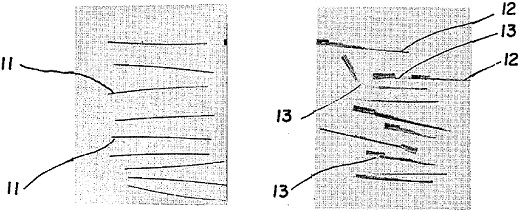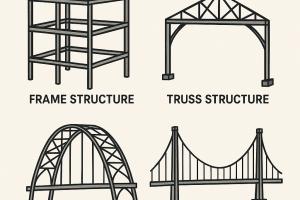Manufacture, Properties and Design of Steel Fibers in Reinforced Concrete
Introduction
Steel fibers are short discontinues strips of specially manufactured steel.Their inclusion in the concrete improves the mechanical properties of concrete significantly. As the most common matrix, which is now in use in construction industry is Reinforced Cement Concrete.
Reinforced cement concrete is combination of steel, cement, aggregates & water. Concrete acts as a compression member. It takes compressive forces resulting due to the applied load and self load. The main problem in concrete is its weakness in resisting tensile forces or pulling forces.To overcome this problem, steel is usually used. Concrete and steel act as a bond, in which lacking in the one are fulfilled by other.
In construction of megastructures like (multistorey buildings, highways, bridges, airport, pavements etc) steel is used for two purposes:
- To Resist Bending Or Flexure
- To Resist Temperature & Shrinkage Effects
Two terminologies related to steel are usually used:
- Main Reinforcement (To Resist Bending Due To Applied Load)
- Temperature & Shrinkage Steel (To Resist Temperature & Shrinkage Changes)
Actually the steel fibers are used as a replacement of temperature steel.But now a days,the research is going on even to replace the main steel. Steel fibers,now-a-days,are of much concern when strength is to be made against blast loading. Beside this, steel fibers are also very effective in making resistance against seismic loading. The injection of steel fibers in concrete converts its nature from brittle to ductile.They not only resist cracking but also make resistance to crack propagation.
Description
Steel fibers were commercially brought into the European market in the1980's. In the beginning, no standards & recommendations were available to accept this new technology. But now,standards & recommendations are available in American & British standards. ASTM A-820 is the standard specification for steel fibers used as reinforcement in concrete.
Manufacturing of steel fibers
|
Carbon |
0.06/0.12% |
|
Manganese |
0.38/0.60% |
|
Phosphorus |
0.055/0.065% |
|
Sulphur |
0.035% |
|
Nitrogen |
0.008/0.12% |
Their manufacturing is done with special type of arrangements. Steel strips are forced into small pieces of steel fibers by introducing large energy. They are produced by two type of failure of steel strips due to energy:
- Brittle failure
- Shear failure
As it is clear from these words that, brittle fracture which occurs at a low-energy impact level with a minimum of plastic deformation so as to produce a straight fiber of uniform cross section, While distinguish this type of fracture from shear fracture which is associated with higher energy absorption than brittle fracture, so as to form steel fibers highly irregular in cross section. Usually the irregular cross sectioned steel fibers are considered more effective than the straight one's.
Steel Fiber Reinforced Concrete Design Consideration
Steel fibers are usually poured into the concrete at the stage of mixing cement, coarse aggregate and fine aggregates. Firstly the cement, fine and coarse aggregates are poured into the mixer after that, steel fibers are used to be poured then water is poured after that this whole assembly is mixed either by hand or by using mechanical equipment.
Their effectiveness can be determined by using following parameters:
- Length
- Diameter
- Aspect ratio(diameter to length ratio)
- Configuration
Steel fibers are usually available in length from 1" to 2". The 1" length provides enhancement in both micro-macro cracking performance and post-first-crack performance of concrete.
Aspect ratio gives better understanding of bonding potentials. Fibers having aspect ratio greater than 2" usually having balling potential. Configuration can be straight, continuous-deformed, or end-deformed. Initially, straight steel fibers were the only available. It was quickly learned that their bonding potential was limited. New products were developed to increase the bond between the fiber and concrete. As a result of which, two configurations emerged as the best one, named as hooked-end, drawn-wire fiber & continuously-deformed, slit-sheet steel fiber.
The continuous-deformed, slit-sheet fibers provide better micro-macro cracking performance, as well as flexural strength enhancement whereas,the end-deformed,drawn-wire steel fibers perform best post-first-crack. As whenever the steel fibers are used in concrete, the problem arises of workability of concrete. Steel fibers usually lowers workability of concrete. Mix becomes harsh. Despite increasing water cement ratio, as it tend to decrease strength of concrete, usually the admixtures are used.
The main objective in designing a structural fiber concrete mix is to produce adequate workability, ease of placing and efficient use of fibers as crack controllers. The ACI committee has given the following guidelines to serve the purpose of Steel fiber reinforced concrete (SFRC) mix design:
- Coarse aggregates should be 55% of the total aggregate.
- W/C should be below 0.55 (0.35 is recommended).
- Minimum cement content of 320 kg/m3 should be used.
- Sand content of 750 -850 kg/m3 is recommended.
- The workability could be improved by increasing the cement paste, which is possible by addition of slag or fly ash to replace the cement.
- Maximum aggregate size should be 19 mm
Properties Of Concrete Which Shows Increase On Inclusion Of Steel Fibers
- Toughness
- Flexural Strength
- Fatigue Endurance
- Impact Strength
- Compressive Strength
- Shear Strength
- Abrasion & Skid Resistance
Conclusion
Steel fiber has an effect ranging from little to significant on the mechanical properties of concrete. Steel fibers are effective for concrete in all aspects.
Problems in their usage:
The main problem in their usage is Economy. Economy matters a lot. As their inclusion in concrete, usually doubles the material cost of the whole assembly, resulting the increase in overall cost of projects, which is usually have great importance in construction. That's why, only rich countries are using steel fibers in construction industry






